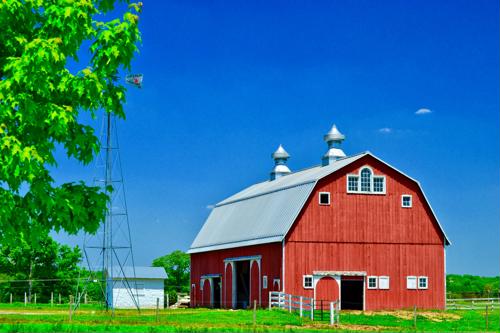When you consider horse health, your mind may turn to high-quality feed, supplement support and allowing your animal enough time for exercise. These are all important, but you should also take into account the importance of air quality in your barn. Air quality can affect horse health in a number of ways – dust particles can cause allergic reactions and infection, for example. Here are a few air quality issues you should be aware of as well as best practices to give your horse a healthy environment to live in:
Understand contaminants
Contaminants and pollutants are often misunderstood. These categories not only include more dangerous substances such as ammonia and carbon monoxide, but also include seemingly less threatening materials such as dust particles and even airborne materials that arise from hay.
“Spores may be present in bedding.”
Straw, for example, may contain fungal spores that your horse can breathe in. Spores may be present in bedding, as horses spend large chunks of time in their stalls surrounded by straw. To combat this issue, opt for bedding alternatives such as peat, paper or wood shavings. However, in stables without proper ventilation, various molds and spores can grow, spreading bacteria and reducing air quality. In addition to proper ventilation, muck out your horse’s stall regularly to prevent any unwanted bacterial growth.
Ammonia may also become a problem. This compound is found in manure and urine and is released when bacteria grows and organic materials decompose. As ammonia is released into the air, horses breathe in the substance, which can affect their respiratory system. In reaction, a horse’s lungs will overproduce mucus, further inhibiting lung activity. Be sure to muck out stalls frequently, with your horse out of their stall. The process of mucking out stalls is highly important for lung health, but during the act itself, ammonia is kicked up into the air, further exposing your horse to this contaminant if left in its stall. Plan a time to muck out stalls when your horse is grazing outside or out for a ride.
Simple dust particles also pose a problem. Just as you may begin sneezing or coughing in a dusty environment, your horses can also experience respiratory issues when in a dust-filled barn. Dust is best handled by ensuring proper ventilation, which we’ll discuss shortly.
Watch the Air Quality Index
“The Air Quality Index helps animal owners to understand what their horses are breathing.”
The Air Quality Index is a measurement of the level of pollutants in the air on a given day, and it’s a valuable resource to help animal owners to understand what their horses are breathing in. Keep an eye out for local weather reports that mention the AQI and check the index yourself regularly. Issues of air quality often become a problem during the hot summer months, when the air becomes stale. It’s frequently a problem on hazy days without a breeze to carry away pollutants, so make sure you keep up with local weather reports during the summer season in particular.
The Air Quality Index measures the levels of carbon monoxide, nitrogen dioxide, ozone, sulfur dioxide and particulate matter. In small doses, these pollutants are not dangerous for animals or humans, but higher levels may make it harder to breathe or take on heavy workloads. On days when the AQI index is high, reaching orange or red levels, pay close attention to your horse’s breathing. If you notice it breathing heavily, heaving or experiencing any respiratory problems, cease work or riding activities and bring it inside to a cool, well ventilated barn.
Ensure proper ventilation
Airflow and ventilation are key to ensuring air quality in your barn. Ventilation can be achieved in three ways – natural, mechanical, or, ideally, a combination of both. Whenever possible as weather permits, leave stall windows and barn doors open to attract a natural breeze to clear out the air. You can place fans in the barn as well to bring in fresh air. Just make sure the fan is place so that it doesn’t recycle dust-filled air in the barn. You can achieve this by placing fans with their backs to an open door or window to propel outside air through the indoor space. During colder months, you can still keep barn doors open for a shortened period of time; ensure your horse stays warm by placing a blanket over them during these times.
You should also consider the benefits of installing mechanical ventilators, which should be designed to grant horses six to eight air changes each hour. Mechanical ventilators promote air quality by providing horses with consistent, fresh air to breathe in while in their stalls. Mechanical ventilators also provide horses with clean air during the times you want to keep barn doors closed, such as during storms or at night when you’re away from your animals. Mechanical ventilators such as fans are rated by their ability to move air, measured in cubic feet per minute. Do some research and ensure the mechanical ventilators of your choice are up to the task of circulating through your barn, depending on its size.








